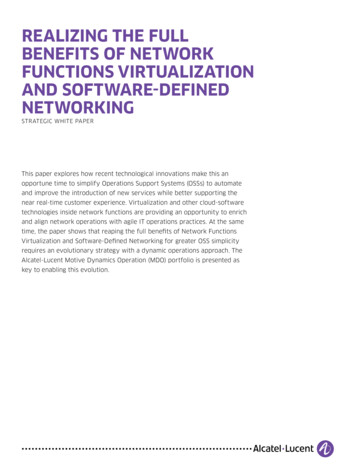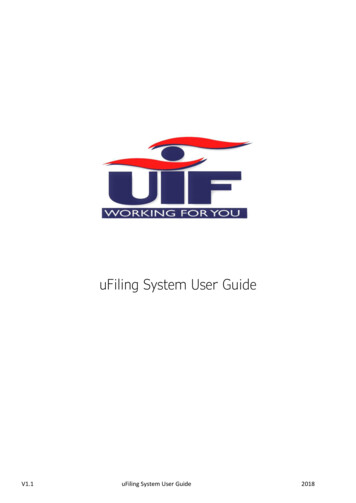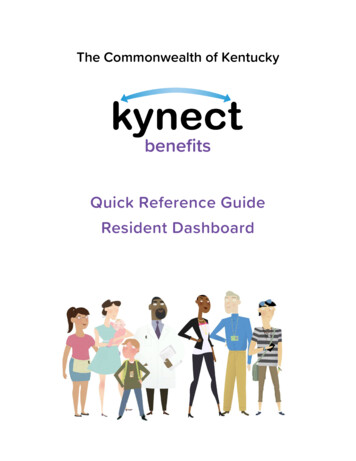
Transcription
REALIZING THE FULLBENEFITS OF NETWORKFUNCTIONS VIRTUALIZATIONAND SOFTWARE-DEFINEDNETWORKINGSTRATEGIC WHITE PAPERThis paper explores how recent technological innovations make this anopportune time to simplify Operations Support Systems (OSSs) to automateand improve the introduction of new services while better supporting thenear real-time customer experience. Virtualization and other cloud-softwaretechnologies inside network functions are providing an opportunity to enrichand align network operations with agile IT operations practices. At the sametime, the paper shows that reaping the full benefits of Network FunctionsVirtualization and Software-Defined Networking for greater OSS simplicityrequires an evolutionary strategy with a dynamic operations approach. TheAlcatel-Lucent Motive Dynamics Operation (MDO) portfolio is presented askey to enabling this evolution.
TABLE OF CONTENTSThe OSS simplification opportunity/1Establishing an enhanced OSS strategy/1NFV readiness / 2Introduction of new operations solutions linked to NFV and SDN technologies / 2The essential role of abstractions/3Implementing the evolution strategy with a dynamic operations approachService models / 4Solution design and deployment/4Alcatel-Lucent Motive Dynamic Operations PortfolioThe Motive SURE Engine/6Standards-based simplificationConclusion/Abbreviations8/9/7/5/3
THE OSS SIMPLIFICATION OPPORTUNITYEver since the rise of Internet-based competition, service providers have been faced withthe need to innovate and simplify their operations support systems (OSSs). They needsolutions that will further reduce operational expenditures (OpEx), allow them to bemore competitive through agile introduction and delivery of new services, and to meetthe growing demand to manage customer experiences in near real-time. These objectiveshave been hard to achieve so far, but new technology trends such as Network FunctionsVirtualization (NFV) and Software-Defined Networking (SDN) are opening new perspectives and opportunities to meet these challenges.Today, a real opportunity exists for service providers to simplify their OSS by introducinga highly automated and dynamic approach to service operations. Why has this opportunity become available?First, the use of virtualization and other cloud software technologies inside network functions and their deployment as applications on IT infrastructure provide the opportunity toenrich and align network operations with agile IT operations practices. Dynamic application lifecycle management principles can be leveraged from the IT world and directlyapplied to network functions. This enables simplification by moving from dedicatedto IT standardized processes, including DevOps automation processes.Second, new flexibility has been introduced by linking the OSS processes to the featuresof NFV orchestrators and SDN controllers as programmable networking technologiesexposed using open APIs. OSS systems that are able to leverage the capabilities of thesedynamic resource managers can also achieve the dynamic operations processes that arerequired to take full advantage of NFV and SDN.Previous approaches to automation and rapid new service introduction, such as low-levelmanagement interface standardization or the use of service delivery platforms (SDPs),have mostly failed to deliver on their promise. However, the far-reaching technologychanges just described present service providers and the industry as a whole with a realgame-changing opportunity. If well planned, these changes can increase service operations automation and make flexible new service introduction possible. In addition, theycan dramatically simplify the OSS while meeting the needs of an end-to-end NFV- andSDN-based dynamic operations environment.ESTABLISHING AN ENHANCED OSS STRATEGYHow can service providers address the evolutionary requirements for optimal, end-to-endoperations supporting cloud, NFV-based and SDN-based services? How can they achievefurther automation and optimization of traditional service operations? Assuming thatthe introduction of new technologies will take some time, an effective evolution strategymust also consider service operations across hybrid networks consisting of both currentand new technologies. In particular, the following two aspects of OSS evolution need tobe addressed, sequentially or in parallel:Realizing the Full Benefits of Network Functions Virtualization and Software-Defined NetworkingALCATEL-LUCENT WHITE PAPER1
NFV readinessThe current OSS needs to be assessed with respect to its capability to move up the valuechain from current to dynamic operations. This includes cleaning up current OSS servicefulfillment, inventory and assurance stacks. This can be done by consolidating andautomating where possible, and by ensuring OSS readiness for dynamic process support.These steps are required in order to play a part in the target OSS for NFV and SDN andto be ready for dynamic operations.Introduction of new operations solutions linked to NFV and SDNtechnologiesThis includes extending or elaborating new operational processes that work acrossnetwork/SDN and cloud/NFV platforms, as well as analyzing their impacts on currentprocesses and organizations. The following areas are of particular concern: Operational process integration with NFV resource management solutions that handlerequired complexity and functions at the lowest level. Operational process connection to near real-time SDN management and controlsolutions that initially address the data center LAN, but are moving into the WANas well. Exploitation of big data analytics solutions that provide high-volume informationgathering and storage, used as the foundation for intelligent processing applicationsthat provide near real-time insights, which can then help steer the dynamic operationsprocesses. See Analytics Engine block in Figure 1. Organization impacts, for example, on network operations and IT departments—organizations will need to interconnect their systems, processes and teams in newand automated ways, and additional technology skills will be required on both sides.Additional impacts, such as on procurement processes, will bring further operationschallenges.As illustrated in Figure 1, an OSS solution architecture ready for NFV and SDN dynamicoperations requires broad technology coverage, new efficient software modules and aunified service and resources view.Figure 1. Motive Dynamic Operations - Solution OverviewMotive dynamic operationsNetwork opsIT/Cloud/DevOpsService management platformService ctivatorAutomatedoperations andrecoveryBig network analyticsService eventmanagerService and UnifiedResource EngineServiceinfrastructureoperationsResource discovery and ve adaptor layerFixed and wireless accessTransportIPSDNApplications and VNFsRealizing the Full Benefits of Network Functions Virtualization and Software-Defined NetworkingALCATEL-LUCENT WHITE PAPER2NFVIT
THE ESSENTIAL ROLE OF ABSTRACTIONSAbstractions are particularly useful for OSS service operation in an NFV and SDN worldwhere highly dynamic resource management may take place in order to avoid serviceimpacts. Abstraction between the resource and service layers is key for end-to-enddynamic operations and OSS simplification. Abstractions are needed to shield the serviceoperations OSS from resource-focused details. Abstraction can be repeated as often asneeded to enable simplified end-to-end service operations. The availability of a simpleinformation model to represent service instances with minimum information at eachlevel of abstraction is essential to this approach. This model allows the implementationof the required object hierarchy, where instances are created dynamically through servicefulfillment or auto-discovery, and which can also be used by dynamic service assuranceprocesses, closing the loop between fulfillment and assurance.For example, to achieve dynamic operations, a divide-and-conquer strategy with anabstraction approach, keeps as much domain-specific knowledge as possible inside therelevant domain managers. Such domain managers might include near real-time applications, such as cloud resource managers (for example, the Alcatel-Lucent CloudBandManagement System or the Nuage Networks Virtual Services Platform) that manageon-demand resources in near real-time. By connecting to such resource managers, highlydynamic and automated operational processes can be achieved to manage services insidethe domain. Abstraction from resource-specific details is vital to ensure that the OSS caneventually be simplified. Abstraction is applied in many places, for example: Resource managers provide configuration, orchestration, fault and performancemanagement functions for their domain. They abstract resource specifics northboundand expose service-focused views to upper service operations systems. Service operations systems provide the dynamic fulfillment/orchestration andassociated dynamic assurance functions, on a per domain, area or other scope basis. End-to-end service fulfillment/orchestration and service assurance, which is asindependent as possible of the underlying technologies, supporting the end-to-endservice operations dashboards. It also exposes business information to businesssupport systems (BSSs) and to customer self-service portals and tools.IMPLEMENTING THE EVOLUTION STRATEGYWITH A DYNAMIC OPERATIONS APPROACHRather than introduce a new technology stack or bolt onto a 15 year-old softwareplatform, one strategy is to use NFV and/or SDN as a compelling event to rejuvenate theoperations approach. The proposed dynamic operations approach targets both currentnetworks and NFV- and/or SDN-enabled networks and is able to have those co-exist in ahybrid way for the foreseeable future. This approach progressively improves all aspectsof network and service operations by introducing automated and dynamic processes, andit increasingly integrates relevant aspects of IT management. This approach also simplifies today’s operations by evolving the current OSS into a state-of-the-art, flexible OSS.As a result, it fosters operational excellence, high degrees of automation for both fulfillment and assurance and adjoining business functions, as well as lower operating costs asa percent of revenue. Moreover, the approach must prepare operations, IT and networkRealizing the Full Benefits of Network Functions Virtualization and Software-Defined NetworkingALCATEL-LUCENT WHITE PAPER3
teams for NFV and SDN gradually or abruptly, depending upon the decided businesstargets. Whatever the starting point, all OSS evolution approaches should contribute toachieving the same common target OSS architecture for dynamic operations across current and SDN-enabled networks, IT and cloud/NFV platforms, as well as current VNFsand applications.Service modelsService models define the abstracted view that the OSS has of network services, IT, andapplication resources. This view enables the OSS to shift focus from resource management to dynamic services operations. The service modeling needs to become the heart ofthis new approach to operations. Alcatel-Lucent has long-standing experience in definingservice models for current network services end-to-end, and is extending its portfoliowith service models covering both NFV- and SDN-based services, as well as hybridservices across current and new networks.Solution design and deploymentService providers may wish to consider different lines of attack to address end-to-end,dynamic operations across current network and IT environments, as well as NFV andSDN. OSS solutions can be defined with the following objectives:Initial standalone deployment of new OSS for NFV and SDNNFV and SDN are to introduce new, highly dynamic resource management functions thatallow management of virtual resources to be separated from management of applicationresources. They can also provide common lifecycle management functions across allVNF and cloud applications. These new functions dynamically manage virtual resourcerequirements driven by applications on demand, high volumes of end users or administrative users, as well as by network-based applications. This dynamic managementis achieved by a set of new systems that might include: Orchestration-based dynamic cloud resource management systems, such as theAlcatel-Lucent CloudBand Management System (CBMS). Policy engines for dynamic virtual network resource allocation and optimization,such as the Nuage Virtual Services Director (VSD) within the Nuage Networks SDNsolution. A big data solution with continuous analytics applications, such as the Motive BigNetwork Analytics solution to support the high volumes and changing conditions.Increase automation in and across current network and IT operationsSelecting Alcatel-Lucent as a partner can quickstart automation programs on currentoperational domains. The company has been productizing years of automation experience in the design and implementation of OSS projects on current networks. The focushas been Operating Expense (OpEx) reduction and customer experience management(CEM) for service providers in the new Motive Dynamic Operations portfolio. This experience, combined with our company knowledge of the NVF platform, SDN technologyand VNF applications, is used to develop innovative service models. These strengthenautomation of service fulfillment and assurance on all types of current networks, including for advanced root cause analysis and auto-recovery orchestration. These new servicemodels also allow the linking of dynamic fulfillment and assurance for innovative planning processes involving both the network and IT, and are designed to ensure readinessfor the introduction of new NFV- and SDN-enabled networks and services.Realizing the Full Benefits of Network Functions Virtualization and Software-Defined NetworkingALCATEL-LUCENT WHITE PAPER4
Operational process integration across current and new OSSsIn the near and mid-term, new NFV and SDN network and application functionswill co-exist with current networks and applications, with services running acrossboth. Therefore, end-to-end dynamic operations need to cross all such functions. Bycombining a software-driven, highly automated approach to network operations and ITmanagement, and by introducing service models for abstraction from resource to serviceoperations, real end-to-end service fulfillment and service assurance can be achieved. Aservice and resource abstraction engine can provide the right and practical data modelthat allows orchestration, correlation and analytical techniques to support dynamicservice operations hierarchically across layers and horizontally across domains. Thisapproach applies to both current networks and IT, as well as to the NFV and SDN arenas.In addition, service models provide a unique opportunity for further streamlining ofexisting OSSs. By introducing abstraction using the service models for current networksand IT in the current OSS, and linking resulting views with the abstract views obtainedthrough the dynamic operations solution defined for NFV and SDN, integration acrossthe current and new OSS can be achieved. Over time, this also enables the consolidationof service operations systems and simplification of the OSS in a phased way.OSS transformationAs of today, any OSS transformation project needs to account for NFV and SDN, whichrequire increased OSS agility. Current OSSs are generally not well equipped to deal withthe highly dynamic behavior offered by the NFV- and SDN-related resource managementfunctions. Although more recent OSSs are mostly adaptable to NFV and SDN, viabilityof older OSSs will need to be assessed. To fully leverage NFV and SDN capabilities, thecomplete OSS will need to become much more dynamic than it is today. For example,policy-driven automation activities need to occur within seconds or minutes rather thanin hours or days. This acceleration will enable service providers to realize the dynamicoperation processes required to stay competitive in the cloud environment. In addition,integration of IT and network operations is essential. As a result, OSS transformationprojects also need to address the new skills sets and organizational changes required.OSS transformational methods enable operators to achieve dynamic operations neededto realize the OpEx reductions promised by NFV and SDN.ALCATEL-LUCENT MOTIVE DYNAMICOPERATIONS PORTFOLIOAlcatel-Lucent has recently unveiled its new Motive Dynamic Operations (MDO) portfolio. This portfolio consists of a modular set of OSS applications designed to reap the fullbenefits of NFV and SDN as fast as possible. It is also designed to assist service providersin continuously increasing the level of automation in their operations environment. TheMDO solution facilitates the definition of transformation projects; it takes service providers through a series of focused transitional steps, which are executed as self-containedprojects. This process prepares for the introduction of NFV and SDN while simplifyingthe existing OSS along the way.Realizing the Full Benefits of Network Functions Virtualization and Software-Defined NetworkingALCATEL-LUCENT WHITE PAPER5
The MDO solution provides applications in essential operational areas, such as:Dynamic Fulfillment: This solution allows for the rapid introduction of new andinnovative services, including agile orchestration for end-to-end services activation.The MDO solution also enables service providers to create a simplified and openfulfillment architecture that works across the network and IT while isolating businessoperations from network management.Dynamic Assurance: This solution addresses customer needs by bringing customer careand network operations closer together through intelligent root cause and service impactanalysis tools. The solution includes analytics-driven automation of service assuranceand also allows service providers to build in proactive, automated processes. Theseprocesses automatically identify and resolve service and network issues, thus avoidingthem through proactive measures.Dynamic Operations for NFV and SDN: This solution enables the operationalizationof NFV- and SDN- based services by closing the loop between Dynamic Assurance andDynamic Fulfillment through a common Service and Unified Resource Engine (SURE)that spans networks and IT and automates the discovery and reconciliation of networkresources.Motive Dynamic Operations innovations are implemented based on OSS solution designpatterns. Each OSS solution design functionally covers Dynamic Fulfillment, DynamicAssurance or both. An actual OSS solution implementation includes Alcatel-Lucent andthird-party products and software, as well as the required active adaptors—the rulesbased software used by OSS components to interact with underlying infrastructure orresource management components.Service models implement Alcatel-Lucent’s longstanding experience and knowledgeconcerning operation of services across multi-vendor networks and IT environments.New service models are being developed as part of the Dynamic Operations solutionfor NFV and SDN.The Motive SURE EngineIn an OSS implementation, abstraction information resides in the Motive Service &Unified Resource Engine (SURE). The Motive SURE creates an end-to-end unifiedview of existing network technologies, IT data center/cloud configuration resources,as well as physical and VNFs. SURE is subsequently used and enriched by bothDynamic Fulfillment and Dynamic Assurance applications.The MDO solution creates the foundation for streamlined dynamic service operationsthat enable service providers to seamlessly migrate existing and new services to efficient,flexible and programmable virtualized networks. As a core asset of the MDO solution,the SURE enables the linkage of the automated service lifecycle management, policybased dynamic fulfillment and analytics-driven dynamic assurance. Together thesecomponents comprise the new and required Dynamic Operations solution that can fullyexploit NFV and SDN capabilities. When choosing to achieve automated and highlydynamic operational processes, the Motive SURE provides the underlying data modeland API implementations that enable the required level of abstraction to operationalizeNFV and SDN.Realizing the Full Benefits of Network Functions Virtualization and Software-Defined NetworkingALCATEL-LUCENT WHITE PAPER6
Figure 2. Motive Service & Unified Resource Engine rationsOpen interfacesService and UnifiedResource EngineServicecatalogueIT and rastructureIP (and access)infrastructureNFV and SDNapplicationsResource discovery and auditAs part of its SURE product offering, Alcatel-Lucent is currently consolidating bestpractices, information and software available from operational OSS projects worldwideinto a catalog of re-usable service models. These models are continuously enriched andrefined over time with the intelligence and experiences gained through the introductionof new technologies. Today, existing service models are being extended and new modelsare being defined as part of the implementation of the Dynamic Operations solution forNFV and SDN.Standards-based simplificationAlcatel-Lucent solutions and the SURE abstraction model derive from and extend industry standards, where these are relevant and available. Examples include: TM Forum and ITIL/DMTF for operational models and processes OASIS TOSCA for VNF descriptor specification OpenStack for NFV Infrastructure management, or OpenFlow for SDN.The latter standards being handled at the resource level eventually allow for furthersimplification at the OSS level; at first, though, they must also be well understood atthe OSS level. Interface technologies, such as REST, JSON and XMPP are preferred forAPI implementation on the new systems. NETCONF/YANG are also candidates to bringfurther standardization for management of network equipment. Moreover, wider adoption may bring further resource management and related OSS simplifications.Realizing the Full Benefits of Network Functions Virtualization and Software-Defined NetworkingALCATEL-LUCENT WHITE PAPER7
The SURE abstraction model has proven its validity and efficiency in actual project implementations for end-to-end service fulfillment and assurance for today’s multi-vendorfixed and wireless access, aggregation, core, transport, data center networks, IT servers,network function and software applications. It is now being extended to cover NFV- andSDN-related services and resources.The full MDO solution is deployed in the Alcatel-Lucent OSS lab where operational usecases for NFV and SDN operations are elaborated. This Dynamic Operations EnablementLab leverages the Alcatel-Lucent IP Transformation Center (IPTC), which offers aworldwide IP and optical networking infrastructure, all types of fixed and wireless accessnetworks, an NFV platform solution (CloudBand), a Nuage Networks SDN solution, aswell as VNFs, such as vIMS/VoLTE, vEPC, and vCDN. The OSS lab is the hands-on usecase engine for designing best-practice NFV and SDN operational processes that supportthe design and development of the Motive Dynamic Operations solution for NFV andSDN. As part of this process, Alcatel-Lucent is delighted to work with customers tojointly design relevant use cases that test NFV and SDN operations.CONCLUSIONThe introduction of NFV and SDN is expected to require a period of hybrid serviceoperations, OSS transition and transformation. The innovative Alcatel-Lucent MDOsolution, based on proven service models and transformation methodologies, allowseach domain to be transformed and abstracted through independent projects in differentorganizations. This further optimizes and automates current operations and preparesfor the introduction of NFV and SDN. The Alcatel-Lucent SURE abstraction model isdesigned to cover network and IT operations and extends to include NFV and SDNrequirements. The abstraction model is a core value that Alcatel-Lucent brings to OSSoptimization and transformation projects.The MDO portfolio automates many of today’s manually intensive OSS processes anddecisions to dynamically react to network, application and device conditions. Theportfolio can also be integrated with Motive Customer Experience solutions to ensurean optimized customer experience. The MDO portfolio also provides near real-timeanalytics, which allow for intelligent decision making based on dynamically detectedconditions.Alcatel-Lucent is in a unique position to help service providers evolve to DynamicOperations, as well as introduce, leverage and operationalize NFV and SDN. As a keypartner, Alcatel-Lucent can design service providers’ best-fit evolutionary or revolutionary migration path for realizing the benefits of an NFV and SDN world.Realizing the Full Benefits of Network Functions Virtualization and Software-Defined NetworkingALCATEL-LUCENT WHITE PAPER8
ABBREVIATIONSBSSBusiness Support SystemsCBMSCloudBand Management SystemCEMCustomer Experience ManagementDevOpsDevelopment OperationsEMSElement Management SystemIPTCIP Transformation CenterMDOMotive Dynamic OperationsNFVNetwork Functions VirtualizationNMSNetwork Management SystemOpExOperating ExpenseOSSOperations Support SystemsSDNSoftware-Defined NetworkingSUREService & Unified Resource EnginevCDNVirtual Content Delivery NetworkvEPCVirtual Enhanced Packet CorevIMS/VoLTEVirtual IP Multimedia Subsystem / Voice over LTEVNFVirtualized Network FunctionsVSDNuage Virtual Services Directorywww.alcatel-lucent.com Alcatel, Lucent, Alcatel-Lucent and the Alcatel-Lucent logo are trademarks ofAlcatel-Lucent. All other trademarks are the property of their respective owners. The information presentedis subject to change without notice. Alcatel-Lucent assumes no responsibility for inaccuracies contained herein.Copyright 2014 Alcatel-Lucent. All rights reserved. MKT2014097581EN (October)
Virtualization and other cloud-software technologies inside network functions are providing an opportunity to enrich and align network operations with agile IT operations practices. At the same time, the paper shows that reaping the full benefits of Network Functions Virtualization and Software-Defined Networking for greater OSS simplicity










